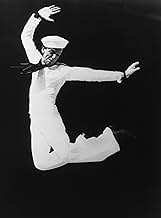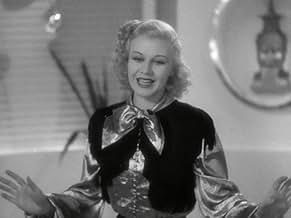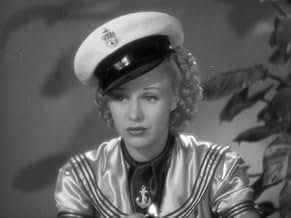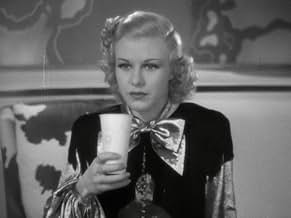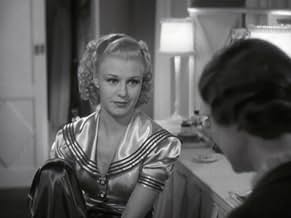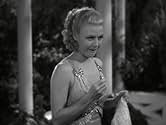IMDb रेटिंग
7.1/10
4.9 हज़ार
आपकी रेटिंग
अपनी भाषा में प्लॉट जोड़ेंA Navy sailor tries to rekindle a romance with the woman he loves while on liberty in San Francisco.A Navy sailor tries to rekindle a romance with the woman he loves while on liberty in San Francisco.A Navy sailor tries to rekindle a romance with the woman he loves while on liberty in San Francisco.
- पुरस्कार
- 4 जीत और कुल 2 नामांकन
Harriet Nelson
- Connie Martin
- (as Harriet Hilliard)
Jean Acker
- Minor Role
- (बिना क्रेडिट के)
Richard Alexander
- Paradise Ballroom Waiter
- (बिना क्रेडिट के)
Constance Bergen
- Ticket Seller
- (बिना क्रेडिट के)
Frederic Blanchard
- Captain Jones
- (बिना क्रेडिट के)
Lynton Brent
- Deck Officer
- (बिना क्रेडिट के)
Phyllis Brooks
- Minor Role
- (बिना क्रेडिट के)
Tom Brower
- Policeman
- (बिना क्रेडिट के)
फ़ीचर्ड समीक्षाएं
Although I enjoyed seeing Harriet Hilliard and Lucille Ball as other characters than Desi's "Lucy" and Ozzie's "Harriet", I would be happy to just watch the final dance number over and over and never see the rest of the movie--it's hauntingly beautiful and the most touching I've ever seen.
It's not just a dance number! With body language alone they act out a very emotional, but unspoken drama.
It's not just a dance number! With body language alone they act out a very emotional, but unspoken drama.
Had this film been put together a tad better, it would be up there with the best of Astaire and Rogers. As it is, it's a fine movie but overly long with a tedious subplot, i.e., Randolph Scott romancing Rogers' sister, played by Harriet Hilliard (that's Ozzie Nelson's wife to you baby boomers).
Astaire and Scott are two Navy men. Scott meets Hilliard the first time when she looks like a stereotypical librarian, and later on after Ginger Rogers has asked her friend (a blond but unmistakable Lucille Ball) to glamor her up.
Meanwhile, Astaire tries to pick up where he and his old dancing partner left off. The result is some wonderful dance numbers, with Astaire and Rogers as a team as well as separately: "I'm Putting All My Eggs in One Basket," "Let Yourself Go," and "I'd Rather Lead the Band."
Hilliard is sweet but a little lethargic as a plain Jane turned glamor girl, although she sings her two songs well, "But Where Are You?" and "Get Thee Behind Me, Satan" - one poster didn't care for that song, but I love the title. Rogers is vivacious, and a youthful Astaire is a dynamo.
The highlight of the movie comes at the end with "Let's Face the Music and Dance," one of the most achingly beautiful songs ever written and certainly one of the most brilliantly executed by Rogers and Astaire. In it, they epitomize '30s glamor and fantasy. It is truly to be treasured and watched again and again.
Astaire and Scott are two Navy men. Scott meets Hilliard the first time when she looks like a stereotypical librarian, and later on after Ginger Rogers has asked her friend (a blond but unmistakable Lucille Ball) to glamor her up.
Meanwhile, Astaire tries to pick up where he and his old dancing partner left off. The result is some wonderful dance numbers, with Astaire and Rogers as a team as well as separately: "I'm Putting All My Eggs in One Basket," "Let Yourself Go," and "I'd Rather Lead the Band."
Hilliard is sweet but a little lethargic as a plain Jane turned glamor girl, although she sings her two songs well, "But Where Are You?" and "Get Thee Behind Me, Satan" - one poster didn't care for that song, but I love the title. Rogers is vivacious, and a youthful Astaire is a dynamo.
The highlight of the movie comes at the end with "Let's Face the Music and Dance," one of the most achingly beautiful songs ever written and certainly one of the most brilliantly executed by Rogers and Astaire. In it, they epitomize '30s glamor and fantasy. It is truly to be treasured and watched again and again.
Musically speaking Irving Berlin gave Fred Astaire and Ginger Rogers another pluperfect musical after Top Hat if that was possible. Although in this case like that Jerome Kern confection Roberta that they were in, Follow the Fleet retained Randolph Scott with another singer, this time Harriet Hilliard.
Randolph Scott is a career Navy CPO and Fred Astaire is an ex-vaudevillian who enlisted in the Navy to forget Ginger Rogers his former partner. But now the two are on shore leave. Fred and Ginger take up right where they left off, and Randy accidentally meets Ginger's dowdy sister Harriet who blossoms into a real beauty. But Randy's a typical love 'em and leave 'em sailor.
Again Irving Berlin wrote a hit filled score with him tightly supervising the production. Ginger gets to do some really outstanding vocalizing with Let Yourself Go which she and Fred later dance to. But the real hit of the show is Let's Face the Music and Dance which is a number done at a Navy show. Sung first by Astaire and later danced to by the pair, Let's Face the Music and Dance is one of the great romantic numbers ever written for the screen. Their dancing on this one is absolute magic.
I'm sure that when I mention Harriet Hilliard a few younger people might ask who that was. But they will know immediately when I mention her in conjunction with her famous husband Ozzie Nelson. That's right Ozzie and Harriet. It's something of a mystery to me why Harriet stopped singing when she just became David and Ricky's mom on television. Then again she didn't even keep her own name.
Neither Ozzie or Harriet sang on television. Ozzie was a pale imitation of Rudy Vallee as a singer, but Harriet could really carry a tune. She sings Get Thee Behind Me Satan and The Moon and I Are Here, But Where Are You, both with real feeling and class. I recommend you see Follow the Fleet if for no other reason than to hear a dimension of Harriet Hilliard incredibly forgotten today.
Randolph Scott is a career Navy CPO and Fred Astaire is an ex-vaudevillian who enlisted in the Navy to forget Ginger Rogers his former partner. But now the two are on shore leave. Fred and Ginger take up right where they left off, and Randy accidentally meets Ginger's dowdy sister Harriet who blossoms into a real beauty. But Randy's a typical love 'em and leave 'em sailor.
Again Irving Berlin wrote a hit filled score with him tightly supervising the production. Ginger gets to do some really outstanding vocalizing with Let Yourself Go which she and Fred later dance to. But the real hit of the show is Let's Face the Music and Dance which is a number done at a Navy show. Sung first by Astaire and later danced to by the pair, Let's Face the Music and Dance is one of the great romantic numbers ever written for the screen. Their dancing on this one is absolute magic.
I'm sure that when I mention Harriet Hilliard a few younger people might ask who that was. But they will know immediately when I mention her in conjunction with her famous husband Ozzie Nelson. That's right Ozzie and Harriet. It's something of a mystery to me why Harriet stopped singing when she just became David and Ricky's mom on television. Then again she didn't even keep her own name.
Neither Ozzie or Harriet sang on television. Ozzie was a pale imitation of Rudy Vallee as a singer, but Harriet could really carry a tune. She sings Get Thee Behind Me Satan and The Moon and I Are Here, But Where Are You, both with real feeling and class. I recommend you see Follow the Fleet if for no other reason than to hear a dimension of Harriet Hilliard incredibly forgotten today.
This film is nice because there are two love stories-- something of a plot departure, and the second couple (Randolph Scott and Harriet Hilliard Nelson) are given the bulk of the dramatics, which allow our stars to be looser, more comical. Astaire chews the gum a little too severely, but he was anxious to make a departure from his customary tuxedoed playboy. Rogers is much more at ease in the role of struggling dancer-singer, and plays well opposite sister Hilliard. (The history is that Ms. Hilliard had to darken her naturally blond hair to distinguish her from Ms. Rogers. But wouldn't they better resemble sisters if they were both blonds?) The Irving Berlin numbers are quite good, ranging from light and airy ("Let Yourself Go," "I'd Rather Lead A Band") to elegant ("Let's Face The Music And Dance"). This final number is the film's bewitching finale, performed on a lovely Art-Deco rooftop and illustrates Astaire's penchant for full-frame, single-take dancing. It is, in a nutshell, singularly gorgeous. The trivia history goes that Rogers' metallic thread gown had weights in the sleeves and hem to make the skirt wind and unwind; the dress was unintentionally difficult to perform in because its flared sleeves hit Astaire across the face IN THE FIRST TAKE- and after many re-shoots trying to cover it up, they ended up printing that first take (we have to assume that was apparently the best performance of the dance, but you can see the sleeves brush across Astaire's face). It loses one-half point from me, because Randolph Scott says 'bebby' once too often.
This is just a great, fun, lovely film. It captures the true essence of the decade and of the people, and tells a beautiful love story of two sisters with two sailors. Though this film may only be in Black and White, it definitely doesn't count against it now in modern days. The main basic purpose of the movie is timeless. This movie features great acting, beautiful song and dance numbers, and great design work and film shots. Follow the Fleet is also comical, there are funny moments, moments that will make you laugh, but other moments where the acting just gets you so involved into the storyline. Its amazing how though this movie may be set in a certain decade, how it can affect those today. If you want to see something great, check this out.
क्या आपको पता है
- ट्रिवियाDuring the fight scene between Fred Astaire and Randolph Scott, Astaire - not skilled in movie fight scenes - accidentally bloodied Scott's nose; Astaire was mortified, but Scott remained pointedly nonchalant.
- भाव
Sherry Martin: Look, why don't you let me try to fix you up? You'll be amazed how much better it will make you feel.
Connie Martin: Even though I'm not a blonde, I could be dumb, couldn't I?
Sherry Martin: And you'll probably do all right too. It takes a lot of brains to be dumb.
- कनेक्शनFeatured in Fred Astaire: Puttin' on His Top Hat (1980)
- साउंडट्रैकWe Saw the Sea
(uncredited)
Written by Irving Berlin
Played during the opening credits
Performed by Fred Astaire and chorus
[Also played as dance music]
टॉप पसंद
रेटिंग देने के लिए साइन-इन करें और वैयक्तिकृत सुझावों के लिए वॉचलिस्ट करें
- How long is Follow the Fleet?Alexa द्वारा संचालित
विवरण
- रिलीज़ की तारीख़
- कंट्री ऑफ़ ओरिजिन
- भाषाएं
- इस रूप में भी जाना जाता है
- Marine gegen Liebeskummer
- फ़िल्माने की जगहें
- उत्पादन कंपनी
- IMDbPro पर और कंपनी क्रेडिट देखें
बॉक्स ऑफ़िस
- बजट
- $7,47,000(अनुमानित)
- चलने की अवधि
- 1 घं 50 मि(110 min)
- रंग
- पक्ष अनुपात
- 1.37 : 1
इस पेज में योगदान दें
किसी बदलाव का सुझाव दें या अनुपलब्ध कॉन्टेंट जोड़ें


